
In the River TAKAHARA --Vol.92--

We went upstream from the junction to the right fork. There was a little water around there.
A Sign of Change
During the evening rise, especially the latter half of it, fish become to respond poorer to the dry fly and better to the wet fly. That happens everywhere and sometimes even before the evening rise. But at the right fork of the source area of the River Takahara that happened extraordinarily early.Why so? I was not sure but felt that it had something to do with the height above the sea.
We will hardly know in advance whether the fish will change its taste unless we know the obvious reason for change. However, if we notice when fish’s attention changes from the dry fly to the wet fly or the contrary, we will be able to change the fishing method at good timing. How can I find the fish’s change as quickly as possible?
In the middle of August Mr. Shohei Katoh and I went to the right fork for the 3rd time. Trying to fish the whole area, we started walking just after breakfast to the junction to descend to the valley.

In the latter half of August some char were light-coloured and fat.
Killer Bee
The sky was very high and our body directly felt ultraviolet rays. Bright sunshine and heat on the white foam of the pocket looked dazzling. Having learned from two experiences, I believed that fish’s taste would suddenly change into the wet fly near the evening. I also knew that fish responded better to the dry fly during the daytime. Preparing ourselves, we started fishing. I put Killer Bee to the leader tip. It was one of the standard flies in mid-summer mountain stream.Killer Bee was made for mid-summer source area. From the latter half of 1970’s, I particularly used the black hackles’ model. As this model was not clearly seen on the stream, I was always careful to send it on the white foam. As far as my eyes could follow it, the fly was very effective in the valley including countless narrow pockets because fish responded to the fly very quickly.
We started fishing upstream. Scarce fish broke the surface for a while. I felt that it did not mean ill response but clearly lack of fish. Fortunately after we passed the power station, char often responded well to the fly.
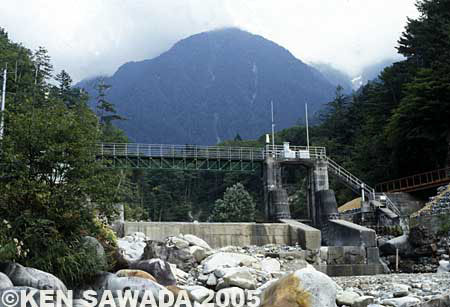
The last sluice gate of the right fork.
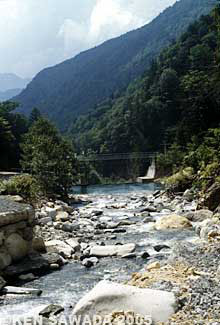
After we passed the sluice gate, the valley had an usual amount of water.
Killer Bee easily loses its buoyancy after it is bitten by the fish, different from spinners like Wild Canary or Spent Badger. After we catch 3 fish successively Killer Bee is easily sunken. Changing the fly into a new one now and then, I fished upstream.
Near the noon we arrived near the white-water creek. Around there the barriers of artificial dams appeared, one after another, and they blocked the stream, which meant the fish number decreased and we had trouble climbing the walls in front of us. To be honest, the barrier of the artificial dam at any valley irritates me.
After we passed the junction of white-water creek there was no more barriers, which made me feel better. A lot of char responded well, which made me feel better, too. But I felt that the fish number was a little bit less than previous two fishing tours. Fortunately the average size seemed to be larger. I did not mean that only big char broke the surface but char had grown for a month since I first came here. Many of them became light-coloured and fat.
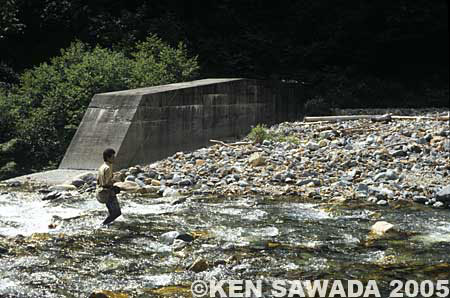
We passed the barrier. The upper part of every barrier was buried under sand.
A Sign of Changing Taste
Glaring sunlight gradually softened in the afternoon. It was after 2 p.m. Killer Bee settled on the white foam, drifted off and at the next moment disappeared with a loud splash. Instantly I set the hook to the fish. It ran straight downstream.Unexpectedly sharp pull made me expect it to be a big fish. However, I felt the pull was somehow strange. The pull was strong but light. An idea came to me and it was right. I landed a char, like a sweet fish caught with a live decoy. The fly was stuck around its pectoral fins.
The char seemed to attack the fly at such high speed that it failed biting the fly or stop biting on the way. Anyway, when the fish turned over the hook caught its body.
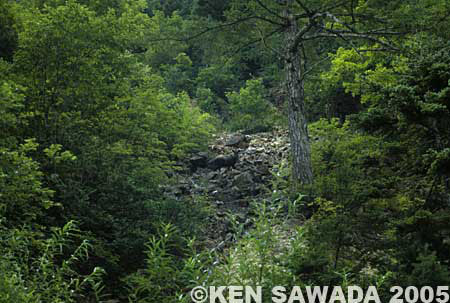
When we went fishing upstream a Japanese serow stared at us as if we had been mysterious things.
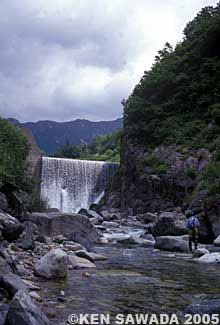
There were a barrier after another at the left fork as well as the right fork.
It is true that Killer Bee is a fly to which fish respond rather quickly but that char’s response was unnaturally quick. That did not suddenly happen but there had been a sign just before.
I mean the char’s response had become quicker and quicker and somehow nervous.
Now char at the right fork were dissatisfied with my dry fly. The char struggling fiercely in front of me was the clearest sign.
When we fish mountain streams with dry fly, especially in the mountainous regions in summer, the fish come near to the fly more slowly as fishing conditions are more desirable. Although too slow access is not a good sign, any kind of fish attacks the fly at desirably slow speed which makes it easy for anglers to set the hook to the fish.
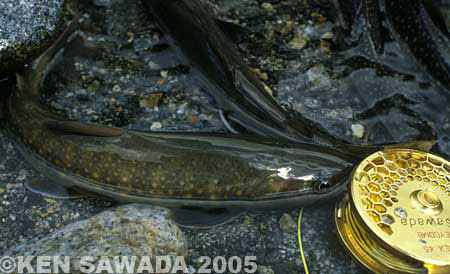
In August the average size of char became a little bit larger and fatter.
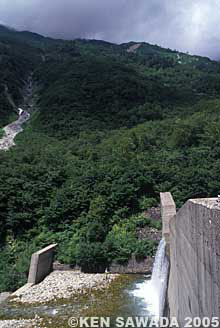
The barrier soared like a pyramid. They appeared one after another.
From a fish’s point of view, the good speed means the speed at which the fish never fail in biting the fly. If they attack the fly at full speed although there is no need to hurry or if they are so slow although the fly will drift away soon, the fish will have no serious intention of biting the fly.
That was why I thought that the change of the fish’s response to Killer Bee showed the change of fish’s taste. If I had had no wet fly I would have changed Killer Bee into Black Coachman or Black Bat to avoid too quick bite. But that would only temporarily prolong effectiveness of the dry fly. Sooner or later, it would become ineffective.
On considering that char’s quick response as a sign, I changed the dry fly into the wet fly. The point was so small that I cut down the butt of 3X leader to 7ft. I had also prepared size 12 Silver Saltoun, one of the standard flies, as the lead fly. Size 10 Jock had been put to 2X dropper.
If my guess is right the fish will respond well to the wet flies. But if not, I will have to think from the first. I was very excited about how the fish would respond.
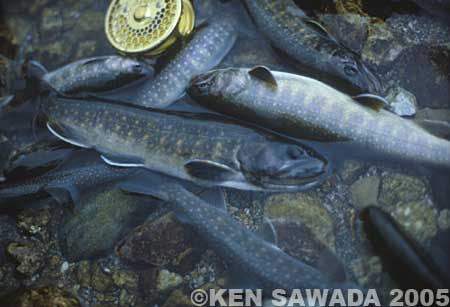
What drives char to change its taste from the dry fly to the wet fly?
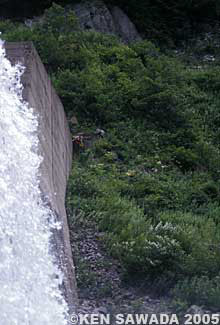
A high barrier causes suffering to both fish and anglers.
For some distance the valley flowed as the shallows. I cast the wet fly upstream in the same way as I had cast the dry fly. I could not see the wet fly but believed that it flowed just under the surface.
I cast the fly near to the opposite bank in order to change the fly-flowing course. Suddenly a char appeared in front of me. Rising from the bottom slowly, it turned over just before it split the surface. I saw all the process and lifted the rod with confidence. I got a desirable response and saw the char running around the current.
Then at the shallow current I made natural drift just under the surface like the dry fly. At the pocket I first sent the fly under the foam and then made it float. In both cases I got proper bites. I could hook the fish more slowly and surely than dry fly although I did not see the wet fly. I was surprised to know how differently the same fish responded to the different type of the fly or drifting. I learned that from fishing the right fork, my commemorative spot.
-- To be continued --
- NET SHOP INFORMATION
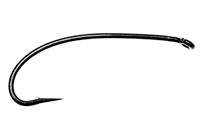
SL6 Black Spey Hooks
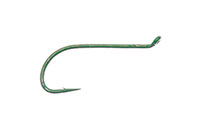
DU3 Limerick Spinner Hooks
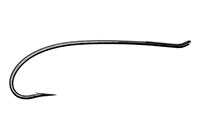
SL4 Single Bartleet Hooks
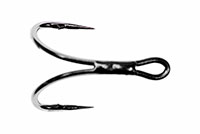
XD1 Tube Fly Double Hooks
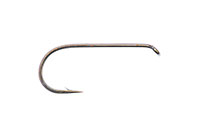
DD2 Flat Perfect Hooks
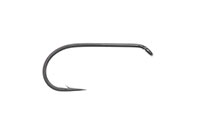
DD1 Black Terrestrial Hooks
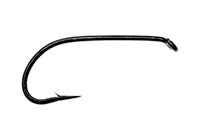
TD4 Old Limerick Wet Hooks
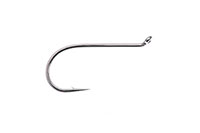
DU1 Silver May Hooks
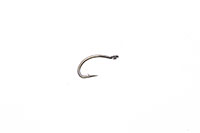
MU1 Flat Midge Hooks
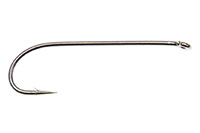
LD3 Long Limerick Hooks
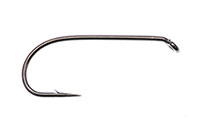
TD2 Summer Sproat Hooks
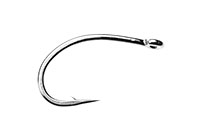
XS1 Tube Single Silver Hooks
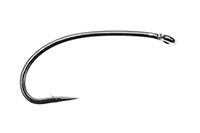
TD6 Siver Sedge Hooks

SL5 Black Spey Hooks

DU3 Limerick Spinner Hooks
- TROPHY CLUB
- FLY SHOW
- EXHIBITION
- MASTERS`
- FLY DRESSING CONTEST Archives
- TRAVELLER Archives
- TACKLE IMPRESSIONS Archives
- ANGLERS` PHOTO GALLERY Archives
- ----------------------------------------------
- トロフィークラブ
- フライショー
- エキシビション
- マスターズ
- フライドレッシング・コンテスト・アーカイヴ
- トラヴェラー・アーカイヴ
- タックル・インプレッション・アーカイヴ
- アングラーズ・フォトギャラリー・アーカイヴ
株式会社サワダ 185-0021 東京都国分寺市南町3-13-4
SAWADA'S INC. 3-13-4 Minamicho, Kokubunji, Tokyo 185-0021, Japan
写真・ドキュメントの無断転載を禁じます。
All the images and documents found on this site are owned by Ken Sawada and may not be used without permission.
But, link to this site is FREE.
Copyright © 2000 - 2025 SAWADA'S INC.. All rights reserved.
SAWADA'S INC. 3-13-4 Minamicho, Kokubunji, Tokyo 185-0021, Japan
写真・ドキュメントの無断転載を禁じます。
All the images and documents found on this site are owned by Ken Sawada and may not be used without permission.
But, link to this site is FREE.
Copyright © 2000 - 2025 SAWADA'S INC.. All rights reserved.
